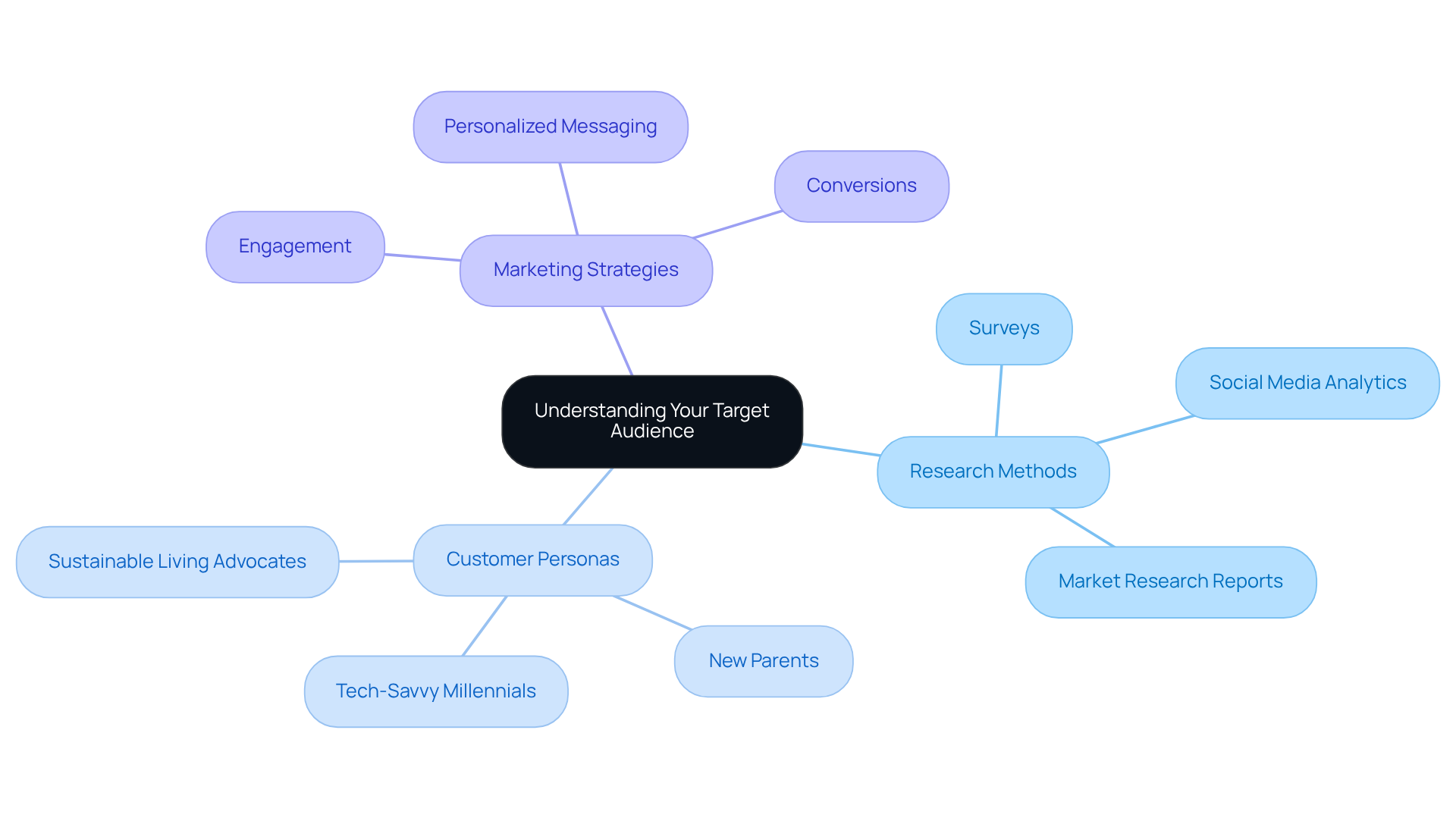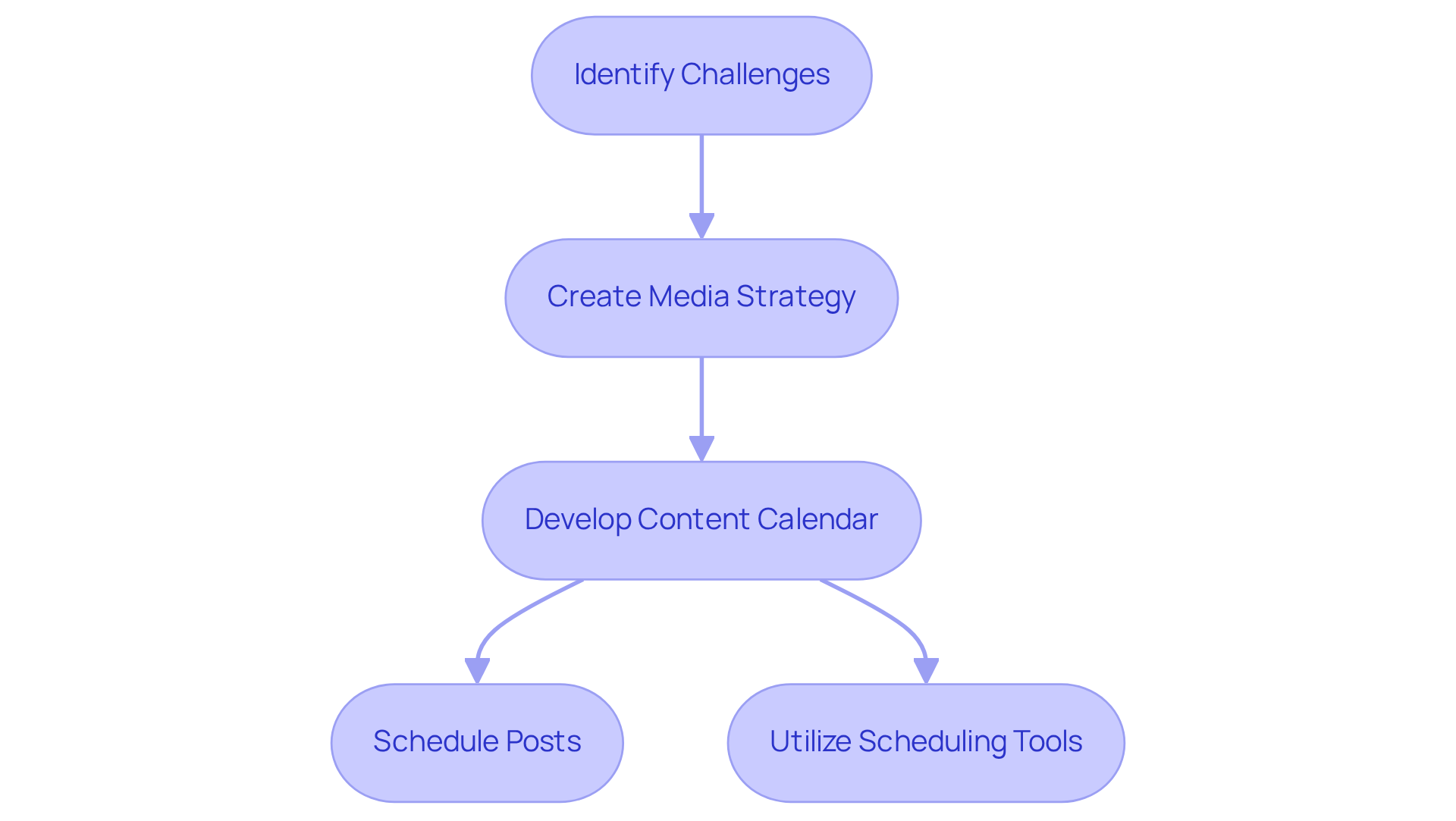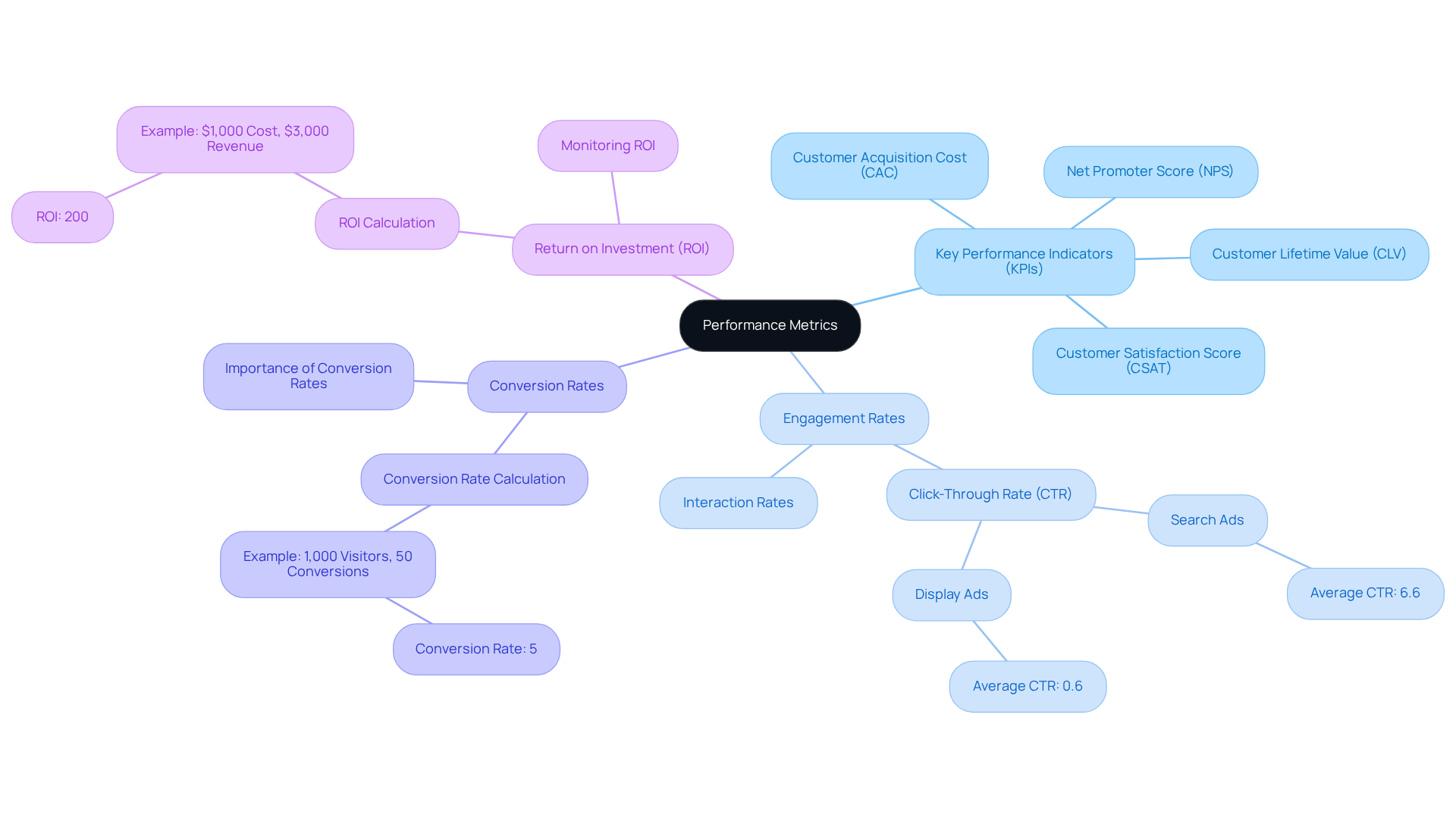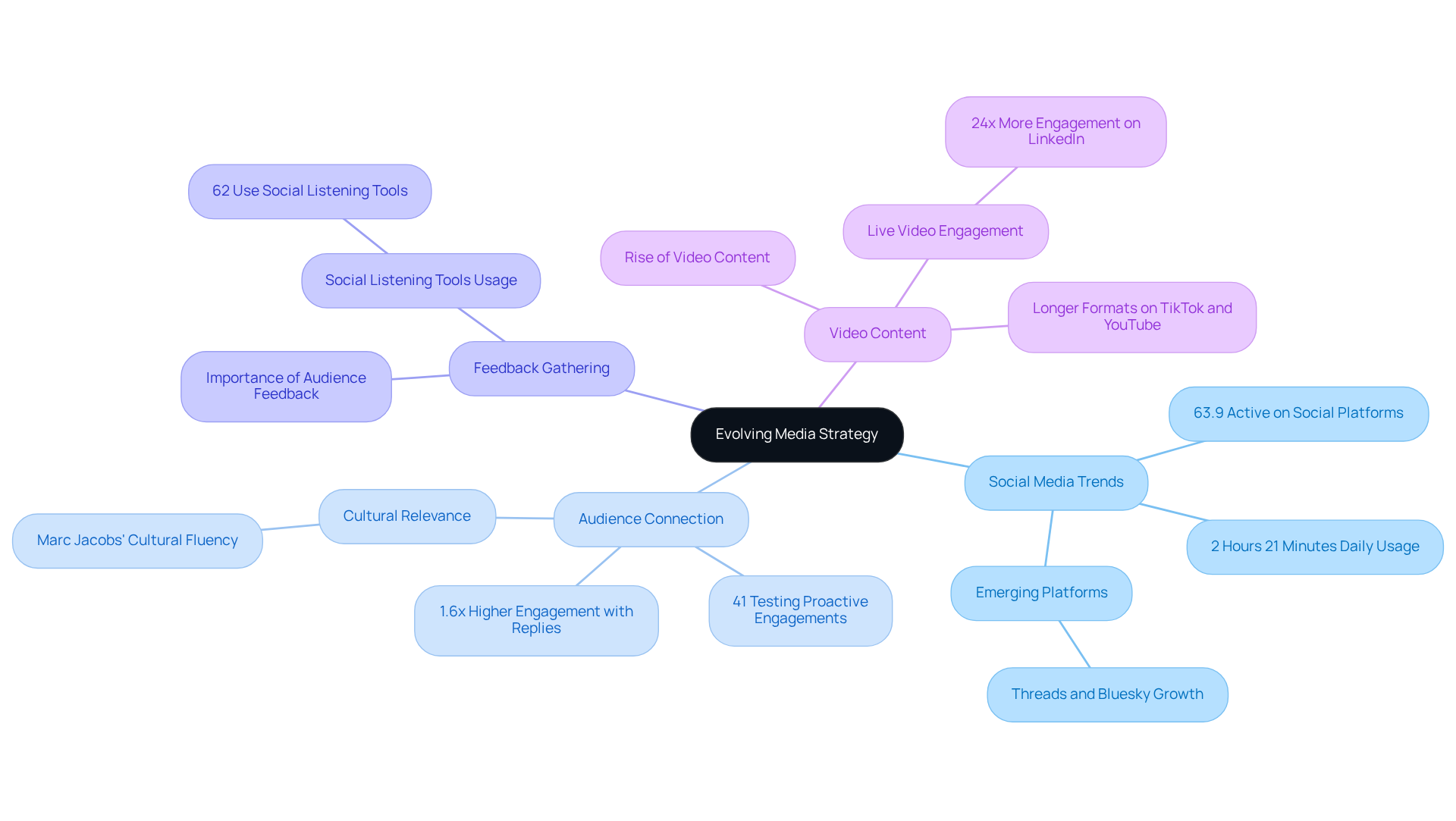Overview
In today's fast-paced world, tech startup founders often struggle with crafting an effective media strategy. This challenge can feel overwhelming, as it encompasses:
- Defining clear objectives
- Understanding the target audience
- Selecting the right media channels
- Creating engaging content
- Planning activities
- Measuring performance
- Evolving the strategy over time
Each of these steps carries its own weight, and without clarity and connection, the journey can become daunting.
However, it’s essential to remember that you are not alone in this. Many founders have faced similar hurdles, feeling the pressure of navigating the complexities of media strategy. The implications of not addressing these challenges can lead to missed opportunities and frustration. Yet, there is hope.
By focusing on clarity, audience connection, and adaptability, you can transform your approach. Each step in your media strategy not only provides actionable insights but also serves as a guide to help you navigate through the noise. Embrace this journey with a nurturing mindset, and allow your strategy to evolve over time, reflecting your growth and the needs of your audience. Together, we can foster a successful media approach that resonates deeply with those you aim to reach.
Introduction
Crafting a media strategy can feel overwhelming for many founders, especially in a time when digital engagement is so crucial. It’s not just about setting objectives; it’s about truly understanding your audience, choosing the right channels, and creating content that speaks to their hearts.
As the media landscape evolves, the question lingers: how can businesses adapt their strategies effectively to not only reach but also engage their target audience? This article explores seven essential steps that will guide you through the intricate journey of developing an effective media strategy, ensuring you feel equipped to navigate the complexities of modern communication.
Remember, you are not alone in this; we are here to support you every step of the way.
Define Your Media Strategy Objectives
As you begin to develop your communication plan, it’s essential to first outline your goals, especially focusing on creative approaches that can . Many founders struggle with defining what they truly wish to achieve, whether it’s increasing brand awareness, generating leads, or driving sales. This can often feel overwhelming.
To address this, consider using the SMART criteria, which can help and make them actionable. For example, instead of simply stating 'enhance brand recognition,' you might specify, ' by 30% in the upcoming quarter through targeted social media initiatives that engage influencers and community advocates.'
This level of clarity not only guides your next steps but also enables you to measure success effectively, particularly in the context of . Remember, you’re not alone in this journey; many founders share similar challenges, and together we can find effective solutions.

Research Your Target Audience
Understanding your is a common challenge that can feel overwhelming, especially when you're trying to expand your . It’s crucial to acknowledge that without this understanding, your efforts may not resonate as deeply as you'd hope. Many founders find themselves frustrated, pouring resources into strategies that don’t yield the desired connection. But there is a way forward. By carrying out thorough research, you can gather , interests, and media consumption habits essential for developing a successful media strategy. Tools like surveys, social media analytics, and can be your allies in this journey.
For instance, consider the tech-savvy millennials who thrive on platforms like Instagram and TikTok. These channels are not just popular; they are vibrant spaces for interaction. By developing comprehensive , you can tailor your content and choose the right channels that align with their preferences. This focused approach not only , ensuring your strategy truly meets the needs of your viewers.
As Mark Williams wisely notes, understanding your customers is essential for effectively directing your marketing efforts. Remember, you’re not alone in this; many founders share similar experiences. By taking these steps, you can cultivate a strategy that feels authentic and responsive to your audience's needs, paving the way for meaningful connections and success.

Select the Right Media Channels
To connect with your target group and achieve your marketing goals, it’s essential to . This can feel overwhelming, but considering a range of options—social platforms, email campaigns, content promotion, and a media strategy—can help clarify the strengths and weaknesses of each. For instance, if your audience primarily engages on social networking sites like Facebook, Instagram, and LinkedIn, you’ll want to prioritize these platforms. It’s noteworthy that , while video content garners five times more interaction, underscoring the importance of .
As you craft your media strategy, aim for a balance between reach and engagement. It’s becoming increasingly clear that , where authentic connections and engaging content flourish. In fact, 56% of younger viewers discover new shows through social media creators, which highlights the necessity for to effectively leverage these channels.
To enhance your , consider integrating . This initiative focuses on scaling omnichannel and executing national user-generated content programs. By fostering partnerships with influencers, you can cultivate a community-driven approach that amplifies your brand's reach and marketability. Additionally, can elevate your brand's presence through innovative design and digital methods.
To ensure your resonates, it’s vital to frequently assess and adjust your approach based on performance metrics and viewer feedback. As Dr. Dave Chaffey reminds us, marketers must remain attuned to the ever-evolving landscape of digital platforms to maximize their impact. By thoughtfully selecting and evaluating communication channels within your media strategy, you can significantly boost your brand's visibility and interaction in a competitive market.

Create Engaging Media Content
Creating engaging media content can often feel overwhelming for tech startup founders who need a solid media strategy. The challenge lies in connecting with your viewers in a meaningful way. By incorporating case studies and , you can gain valuable insights into .
Take, for instance, RNO1's partnership with Founder's Haven, which beautifully illustrates how can empower modern founders on their digital journey. Similarly, our collaboration with Cirkul highlights our in hyper-scaling eCommerce, showcasing innovative approaches to .
Utilizing storytelling techniques can transform your content into something relatable and memorable. Imagine integrating videos and infographics that spotlight , such as those with EOS Network Foundation and Spring Labs.
These elements not only enhance viewer engagement but also play a crucial role in your media strategy by addressing the unique challenges your audience faces, providing practical solutions and inspiration for their own endeavors. By focusing on their pain points and offering how-to guides, you can ensure your content remains both informative and appealing, fostering a nurturing environment where startup founders feel supported in their journeys.

Plan and Schedule Your Media Activities
Engaging your audience can often feel like a daunting task. Many founders struggle with knowing when and where to publish their content as they develop their , especially when considering the seasonal trends and product launches that can significantly influence interactions. It’s important to recognize that these challenges can lead to frustration and missed opportunities. However, there is a way to navigate this landscape with confidence.
Creating a [media strategy](https://blog.rno1.com/4-essential-e-marketing-strategies-for-tech-startups) that incorporates a is a nurturing step that outlines when and where each piece of content will be published. Think of it as a media strategy that guides you through the busy seasons, assisting you in planning for those pivotal moments that can spark excitement among your audience. Additionally, consider innovative strategies for scaling your omnichannel brand ambassador programs. Scheduling and community involvement initiatives can foster deeper connections and broaden your reach.
Utilizing can also alleviate some of the pressure by automating posts, ensuring consistency in your messaging. For instance, if you’re preparing to introduce a new product, envision a sequence of promotional posts leading up to the launch date. By leveraging your influencer network, you can create a buzz that not only excites your audience but also encourages meaningful interaction. Remember, you’re not alone in this journey; many founders share similar experiences, and together, we can find solutions that resonate.

Measure and Analyze Performance Metrics
Assessing media performance can feel daunting, especially when you’re striving to meet the goals of your media strategy. It’s essential to establish that resonate with your goals. Key metrics like , , and return on investment (ROI) are vital. For instance, if your aim is to increase website traffic, consider tracking the number of visitors and on your site. Regularly utilizing , such as Google Analytics, can illuminate these metrics, helping you monitor trends over time.
Engagement rates, which reveal how actively users interact with your content, are crucial for evaluating the effectiveness of your media strategy. A higher interaction rate often correlates with increased brand loyalty and customer satisfaction. Did you know that the typical click-through rate (CTR) is around 6.6 percent for search and 0.6 percent for display advertisements? This standard can serve as a benchmark for assessing interaction rates in your digital marketing campaigns. Similarly, conversion rates—calculated by dividing the number of conversions by total visitors—indicate how effectively your promotional efforts lead to desired actions, such as purchases or sign-ups. For example, if your site has 1,000 visitors and 50 conversions, you achieve a conversion rate of 5 percent, highlighting the importance of strategies that enhance user engagement.
Moreover, is crucial for understanding the financial impact of your media strategy in advertising campaigns. If a campaign costs $1,000 and generates $3,000 in revenue, the ROI would be 200 percent, showcasing the campaign's effectiveness.
Examples of successful KPI tracking include monitoring to optimize marketing budgets and analyzing customer retention rates to gauge loyalty. As noted by Harvard Business School Professor Sunil Gupta, it’s not sufficient to measure just the final outcome; tracking intermediate metrics is essential to uncover bottlenecks in the marketing funnel. By adjusting your communication strategy based on data insights, you can better connect with audience preferences and behaviors, ultimately driving more effective results in your digital marketing efforts.

Evolve Your Media Strategy Over Time
In today's fast-paced world, many founders struggle to keep their communication strategies relevant. With a staggering , it can feel overwhelming to stay ahead of . The pain of falling behind is real; as video content continues to rise in popularity—evidenced by platforms like TikTok and YouTube allowing longer formats—it’s crucial to consider how you can enhance your within your . Connecting with your audience is vital. and help you adapt to their preferences.
By embracing change and leveraging insights, you can ensure your media strategy is . This adaptability is not just beneficial; it’s essential. In fact, 41% of organizations are exploring proactive engagements to boost and drive meaningful results. Remember, you’re not alone in this journey. and and fulfills your objectives.

Conclusion
Crafting an effective media strategy can often feel overwhelming for founders, as it involves navigating a multifaceted process filled with uncertainties. It’s essential to focus on clear objectives and truly understand your target audience. Selecting the right media channels, creating engaging content, and regularly measuring performance are all critical steps in this journey. However, it’s crucial to remember that adaptability is key; evolving your strategies in response to audience feedback and emerging trends is vital for sustained success.
Many founders struggle with specificity in goal-setting and the depth of audience research. Choosing the right platforms can seem daunting, yet it is significant for maximizing engagement. Compelling content that resonates with viewers, paired with a structured approach to scheduling media activities, can enhance brand visibility and foster deeper connections. By monitoring performance metrics, you can continuously refine your strategies, ensuring that your efforts align with your overarching business objectives.
Ultimately, developing a media strategy is a journey best not undertaken alone. By sharing experiences and insights, you can create a collaborative environment that drives innovation and growth. Embracing change and proactively evolving your strategies will not only enhance audience engagement but also pave the way for meaningful connections. These connections are what contribute to long-term success in an ever-changing digital landscape. Remember, you are not alone in this; together, we can navigate these challenges and thrive.
Frequently Asked Questions
What should be the first step in developing a media strategy?
The first step is to outline your goals, focusing on creative approaches that can expand your omnichannel brand ambassador initiatives.
How can I clarify my media strategy objectives?
You can clarify your objectives by using the SMART criteria, which helps make your goals specific, measurable, achievable, relevant, and time-bound.
Can you provide an example of a SMART goal?
Instead of a vague goal like 'enhance brand recognition,' a SMART goal could be 'boost brand recognition by 30% in the upcoming quarter through targeted social media initiatives that engage influencers and community advocates.'
Why is it important to understand my target audience?
Understanding your target audience is crucial because it ensures your efforts resonate deeply, allowing you to connect effectively and avoid wasting resources on ineffective strategies.
What methods can I use to research my target audience?
You can use tools such as surveys, social media analytics, and market research reports to gather insights about your audience's demographics, interests, and media consumption habits.
How can developing customer personas help my media strategy?
Developing comprehensive customer personas allows you to tailor your content and select the right channels that align with your ideal clients' preferences, enhancing engagement and boosting conversions.
What is the significance of knowing my customers in marketing?
Knowing your customers is essential for effectively directing your marketing efforts and creating strategies that feel authentic and responsive to their needs.




